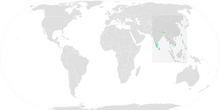Besra
| Besra | |
|---|---|

| |
| Besra Sparrowhawk at Waththegama, Sri Lanka | |
| Scientific classification | |
| Domain: | Eukaryota |
| Kingdom: | Animalia |
| Phylum: | Chordata |
| Class: | Aves |
| Order: | Accipitriformes |
| Family: | Accipitridae |
| Genus: | Tachyspiza |
| Species: | T. virgata
|
| Binomial name | |
| Tachyspiza virgata (Temminck, 1822)
| |

| |
| Global range Year-Round Range Summer Range Winter Range
| |
The besra (Tachyspiza virgata), also called the besra sparrowhawk, is a bird of prey in the family Accipitridae. It was formerly placed in the genus Accipiter. The name "besra" is from the Hindi word for the species.
The besra is a widespread resident breeder in dense forests throughout southern Asia, ranging from the Indian subcontinent eastwards across Southeast Asia and into East Asia. It nests in trees, building a new nest each year. It lays 2 to 5 eggs. It is a medium-sized raptor (29 to 36 cm) with short broad wings and a long tail, both adaptations to fast maneuvering through dense vegetation. The normal flight of this species is a characteristic "flap–flap–glide".
This species is like a darker version of the widespread shikra with darker upperparts, strongly barred underwing, broader gular stripe and thin long legs and toes. The adult male besra has dark blue-grey upperparts, and is white, barred reddish brown below. The larger female is browner above than the male. The juvenile is dark brown above and white, barred with brown below. In all plumages have 3-4 equally sized dark bands on uppertail.
In winter, the besra will emerge into more open woodland including savannah and cultivation. Its hunting technique is similar to other small hawks such as the sparrowhawk and the sharp-shinned hawk, relying on surprise as it flies from a hidden perch or flicks over a bush to catch its prey unaware.
The prey is lizards, dragonflies, and small birds and mammals.


Taxonomy
[edit]The besra was formally described and illustrated in 1822 by the Dutch zoologist Coenraad Jacob Temminck based on a specimen collected on the island of Java. He coined the binomial name Falco virgatus.[2][3] The specific epithet virgatus is Latin meaning "striped" or "streaked".[4] The species was formerly placed in the genus Accipiter. In 2024 a comprehensive molecular phylogenetic study of the Accipitridae confirmed earlier work that had shown that the genus was polyphyletic.[5][6] To resolve the non-monophyly, Accipiter was divided into six genera. The genus Tachyspiza was resurrected to accommodate the besra together with 26 other species that had previously been placed in Accipiter. The resurrected genus had been introduced in 1844 by the German naturalist Johann Jakob Kaup.[7] The genus name combines the Ancient Greek ταχυς (takhus) meaning "fast" with σπιζιας (spizias) meaning "hawk".[8] The English "besra" is from the Hindi word Besrā for a female besra.[9]
Ten subspecies are recognised:[7]
- T. v. affinis (Hodgson, 1836) – west Himalayas to central China and Indochina
- T. v. fuscipectus (Mees, 1970) – Taiwan
- T. v. besra (Jerdon, 1839) – south India and Sri Lanka
- T. v. vanbemmeli (Voous, 1950) – montane Sumatra
- T. v. rufotibialis (Sharpe, 1887) – montane Borneo
- T. v. virgata (Temminck, 1822) – montane Java and Bali
- T. v. quinquefasciata (Mees, 1984) – montane Flores (central Lesser Sunda Islands)
- T. v. abdulalii (Mees, 1981) – Andaman and Nicobar Islands
- T. v. confusa (Hartert, EJO, 1910) – north, central Philippines
- T. v. quagga (Parkes, 1973) – central, south Philippines (except Palawan group and Sulu Archipelago)
References
[edit]- ^ BirdLife International (2016). "Accipiter virgatus". IUCN Red List of Threatened Species. 2016: e.T22695588A93517794. doi:10.2305/IUCN.UK.2016-3.RLTS.T22695588A93517794.en. Retrieved 11 November 2021.
- ^ Temminck, Coenraad Jacob (1822). Nouveau recueil de planches coloriées d'oiseaux, pour servir de suite et de complément aux planches enluminées de Buffon (in French). Vol. 1. Paris: F.G. Levrault. Plate 109, livraison 19. The 5 volumes were originally issued in 102 livraison (parts), 1820-1839. For the dates see: Dickinson, E.C. (2001). "Systematic notes on Asian birds. 9. The Nouveau recueil de planches coloriées of Temminck & Laugier (1820–1839)". Zoologische Verhandelingen, Leiden. 335: 7–53.
- ^ Mayr, Ernst; Cottrell, G. William, eds. (1979). Check-List of Birds of the World. Vol. 1 (2nd ed.). Cambridge, Massachusetts: Museum of Comparative Zoology. p. 339.
- ^ Jobling, James A. "virgatus". The Key to Scientific Names. Cornell Lab of Ornithology. Retrieved 27 August 2024.
- ^ Catanach, T.A.; Halley, M.R.; Pirro, S. (2024). "Enigmas no longer: using ultraconserved elements to place several unusual hawk taxa and address the non-monophyly of the genus Accipiter (Accipitriformes: Accipitridae)". Biological Journal of the Linnean Society: blae028. doi:10.1093/biolinnean/blae028.
- ^ Mindell, D.; Fuchs, J.; Johnson, J. (2018). "Phylogeny, taxonomy, and geographic diversity of diurnal raptors: Falconiformes, Accipitriformes, and Cathartiformes". In Sarasola, J.H.; Grange, J.M.; Negro, J.J. (eds.). Birds of Prey: Biology and conservation in the XXI century. Cham, Switzerland: Springer. pp. 3–32. ISBN 978-3-319-73744-7.
- ^ a b Gill, Frank; Donsker, David; Rasmussen, Pamela, eds. (August 2024). "Hoatzin, New World vultures, Secretarybird, raptors". IOC World Bird List Version 14.2. International Ornithologists' Union. Retrieved 27 August 2024.
- ^ Jobling, James A. "Tachyspiza". The Key to Scientific Names. Cornell Lab of Ornithology. Retrieved 27 August 2024.
- ^ Jobling, James A. "besra". The Key to Scientific Names. Cornell Lab of Ornithology. Retrieved 27 August 2024.
- Birds of India by Grimmett, Inskipp and Inskipp, ISBN 0-691-04910-6

